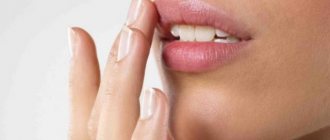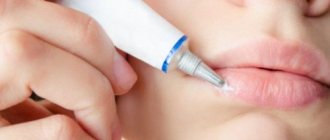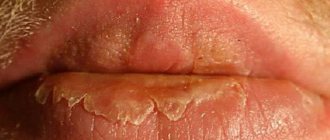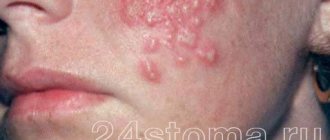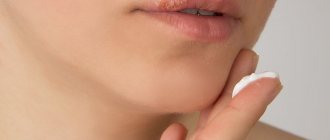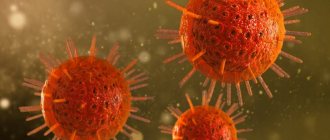Cheilitis is a disease and inflammation that is expressed by damage to the lips (“cheilitis on the lips"), more precisely, inflammation of the red border, mucous membrane of the lips and (in some cases) the skin of the lips. According to medical classification, there are different types of cheilitis. For example, simple cheilitis (Cheilitis simplex, the most common form), angular cheilitis (Cheilitis angularis, or angular cheilitis, or jamming, or inflammation of the corners of the mouth). Cheilitis can be either an independent disease (for example, exfoliative cheilitis, glandular cheilitis, actinic cheilitis), or a symptom of other diseases (for example, atopic cheilitis, eczematous cheilitis). There are more than twenty types or types of cheilitis.
How does the virus become infected?
The virus can be infected in different ways: airborne droplets, contact (through shared towels, cutlery, through kissing), sexual intercourse, self-expression (when the virus from ulcers enters healthy mucous membranes and infects them). You can become infected through a blood transfusion and a child can receive the virus from the mother in utero. The incubation period (from the moment of contact until the first signs appear) is 2-14 days. A person becomes contagious as soon as sores appear on the lip, and is contagious to others until the scabs fall off .
Photo: One of the most common ways of transmitting herpes is contact.
How to treat lips with cheilitis
The most important thing in treating cheilitis is to identify its cause, which is difficult to do without professional help. You'll have to contact a specialist. First, it is better to go to a therapist, and he will then refer you to a specialist doctor.
Typically, treatment for diseases of the lips and skin around the mouth is based on eliminating not the symptoms, but the root cause. It includes lifestyle changes, proper nutrition, and medication.
If the cause of inflammation is an infectious or fungal infection, local drugs are included in the therapy. Typically, patients are prescribed various medicinal ointments for external use, which must be applied to damaged skin several times a day:
- anti-inflammatory – Tetracycline, Erythromycin;
- antifungal – Clotrimazole;
- hormonal – Prednisolone.
To cure lips, you need to influence them not only from the outside, but also from the inside. The skin around the mouth often suffers from a lack of B vitamins, so they are often prescribed in the treatment of lips.
Why do cold sores appear on the lips?
Those who suffer from herpes have noticed that exacerbations begin along with ARVI. Herpes occurs when immunity decreases, the protective forces of which are used to suppress ARVI. Colds on the lips also appear when the body’s defenses are weakened: with chronic fatigue, lack of sleep, frequent stress, poor diet, alcohol abuse and active smoking, in women at the beginning of pregnancy and in the first 5-7 days after childbirth.
Photo: Colds on the lips can only appear if the immune system is weakened
Reasons why lip diseases develop
{banner_banstat0}
Human lips are very vulnerable, which often leads to redness, irritation, dryness, and even the formation of wounds and crusts. Most often, cheilitis develops under the influence of external factors.
: low temperature, wind, sun rays. Under their influence, the skin around the mouth dries out, which in itself is unpleasant. If you don't do anything about it, the problem will only get worse.
The second factor that causes lip diseases is various allergens. The culprit of the pathological reaction can be both food and cosmetics. Problems in the functioning of the internal systems of the body can also affect the face.
Most often, the delicate skin around the mouth suffers due to hormonal imbalances, fungal and viral infections. Vitamin deficiency, indigestion and general deterioration of immunity can aggravate the situation.
There are also less common causes of lip disease. They usually lead to certain types of cheilitis.
How does herpes manifest?
In medicine, it is customary to distinguish 5 stages of the development of herpes simplex: 1. The first stage occurs when blisters appear. It manifests itself as burning and itching in the lip area, and its swelling. 2. The second stage begins with the appearance of bubbles. At first small, they grow and fill with clear liquid. After a couple of days the liquid becomes cloudy. 3. The third stage of the disease is characterized by rupture of the vesicles. In place of the burst blisters, ulcers with swelling form. This stage is dangerous due to the development of complications. The person at this moment is very contagious. 4. In the fourth stage, the ulcers become covered with a dense crust. 5. At the fifth stage, the crusts dry out and fall off. The symptoms go away. The person becomes no longer contagious.
How to get rid of unpleasant symptoms at home
{banner_banstat7}
It is not worth treating at home without seeing a doctor. However, there are ways that you can resort to to reduce discomfort:
- If your lips become inflamed due to the sun or cold, it is advisable that they are always covered with a protective layer of balm.
- For severe itching and burning, which occur in almost all forms of cheilitis, cold compresses will help. Before applying them, the skin is covered with a layer of balm so that the lips are treated simultaneously with the reduction of pain.
- If your lips are red and covered with cracks, sores or any other open wounds, you need to make sure that bacteria do not get into them. The surrounding skin and teeth should be treated with a cotton pad soaked in hydrogen peroxide or Miramistin. Special antiseptic ointments will have the best effect.
- If pain and itching are unbearable, painkillers can be used. Ointments with a cooling effect will have the same effect.
All methods of folk treatment for cheilitis will be useless if you resort to them thoughtlessly - without consulting a doctor. In most cases, inflammation, redness and itching of the lips are harmless. Such symptoms can go away even without therapy, but sometimes they indicate dangerous diseases, so medical help should not be neglected.
How can herpes be dangerous?
Herpes can cause many complications. Some of them are life-threatening.
- Bacterial complications. Most often, bacteria simply attach to the virus and the blisters fill with pus. If the blisters have already burst, then the ulcers become covered with pus, the pain in the lip becomes unbearable and a crust does not form.
- Herpetic stomatitis is a lesion of the oral mucosa. The disease begins with a sharp increase in temperature, salivation and sharp pain when chewing food. There are many blisters in the mouth, similar to herpes on the lips.
- Herpetic eye damage begins with pain in the eyes and lacrimation. A person cannot open his eyes due to severe pain. A dangerous condition that can result in blindness.
- Herpes of the esophagus. Occurs when herpes spreads from the lips. There are difficulties when swallowing, severe pain, refusal to eat and weight loss.
- Herpetic pneumonia and herpetic hepatitis occur in people with immunodeficiency and occur together with bacterial and fungal processes.
- Herpetic damage to the nervous system occurs in the form of meningoencephalitis and is the most severe form of herpes. It begins with a sharp headache, nausea and vomiting, high fever, movement disorders and convulsions. The disease is unfavorable.
Photo: To avoid complications, you need to start treating herpes in a timely manner.
Causes of lip inflammation, cheilitis
Due to the variety of lip diseases (cheilitis), each of them may have its own cause or group of causes. These may be allergic reactions to food or cosmetics, infections (viral, bacterial, fungal), deficient conditions of the body (for example, iron deficiency), the effects of medications, excessive UV radiation, internal pathologies, etc. Even factors such as exposure to constant wind, cold conditions (that is, weather factors), and increased dry skin can lead to inflammation of the lips (so-called meteorological cheilitis).
Exfoliative cheilitis. Usually it is chronic in nature and is expressed in inflammation of the border (edge) of the lips, most often on the lower lip. It is especially common in women between twenty and forty years old, who often lick or bite their lips. The reasons have not been fully established, but suggest genetic factors and pathologies of the immune system.
Haylit Manganotti. Represents a precancerous condition of the lower lip. Usually appears in men over sixty years of age. 1-2 erosions appear on the practically unchanged border of the lower lip. It is believed that among the provoking factors are: injuries, excessive UV radiation, vitamin A deficiency, diseases of the stomach and intestines. Predisposing factors: age-related changes in labial tissues, decreased efficiency of mucous membrane regeneration.
Eczematous cheilitis. Sharp, rapid, accelerated swelling of the lip border. Small bubble formations appear, spreading to the skin of the lips. There can be many reasons: infection with microorganisms, a reaction to fillings, dental materials and oral hygiene products, to food and medicine.
Atopic cheilitis. Damage to the borders of the lips, spreading to the adjacent skin, especially to the corners of the mouth. It is characteristic that the inflammation does not spread to the mucous membrane of the lips. Usually, but not always, it accompanies the symptoms of atopic dermatitis (it has a genetic nature) when allergens are introduced into the body.
Candidal cheilitis. Usually a consequence of candidal stomatitis (fungal). But an equally common case is a lesion in older people with a low bite of the teeth, leading to deep folds at the corners of the mouth. Folds, if hygiene is insufficient, are a place where fungal microflora accumulates.
Actinic cheilitis. The reason is excessive solar irradiation, or more precisely, irradiation with the UV component of the solar spectrum. All common symptoms of lesions and cheilitis appear on the lips.
Glandular cheilitis. A specific type or type of lesion, and is associated with inflammation of the smallest salivary glands located in the mucous membrane of the lips. It can develop both against the background of congenital anomalies of the labial salivary glands, and as a consequence of certain dermatological diseases. A characteristic symptom is the periodic release of droplets of saliva on the lips or pus during secondary infection.
Granulomatous cheilitis. The main symptom is thickening of the lips, especially the lower ones, and trunk-shaped protrusion of the lips. Accompanied by other symptoms (fever, headache). Associated with the formation of small granulomas in the tissues of the lips, and the danger is associated with constant relapses and a persistent increase in the size of the lip tissues.
Allergic cheilitis of contact type. Delayed allergic reaction to lipstick, toothpaste, dental materials (for example, denture materials).
Actinic
Reason . Increased sensitivity of the red border of the lips to ultraviolet radiation. The disease appears in the spring-summer season, and by autumn it disappears by itself.
Article on the topic
Lipstick: history of creation and subtleties of use
Symptoms .
The red border of the lower lip swells, becomes bright red, powdered with small white scales. Sometimes small bubbles appear, after opening which crusts form. Patients are concerned about itching, burning, and less often sore lips. Treatment and prevention . You should not only reduce your exposure to sunlight, but also start constantly using sunscreen cosmetics. Ointments with hormones (hydrocortisone, prednisolone, etc.) can be used topically. Inside - vitamins. Rinse your mouth with herbs.
Meteorological
Reason . Exposure to cold air, strong wind. It occurs more often in men, especially those who suffer from general weather sensitivity or work outdoors.
Symptoms . Peeling, itching and dryness, as well as erosions and crusts on the lips. Cracks in the corners of the mouth.
Treatment and prevention. If possible, minimize exposure to cold and wind. Use protective cosmetics for lips. Take B vitamins internally, as well as PP. Use special wound-healing ointments externally and often rinse your mouth with extracts of chamomile, oak bark, and calendula.
